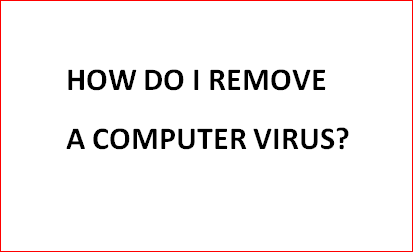HOW DO I REMOVE A COMPUTER VIRUS?
How do I remove a computer virus?
Here are a few things you can try to remove a computer virus:
Keep your antivirus program up to
date.
If you have already installed an antivirus program on your
computer, it's important that you keep it up to date. Because new viruses are
being written all the time, most antivirus programs are updated frequently.
Check your antivirus program's documentation or visit their website to learn how
to receive updates. Be aware that some viruses block common antivirus websites,
making it so you cannot go to the website to download antivirus updates. If this
happens, check with your antivirus vendor to see if they have a disc you can use
to install the latest updates. It might be possible for you to create this disc
on a computer that is not infected (for example, on a friend's computer).
Use an online scanner.
If
you don't have antivirus software installed, visit the Windows Security Software Providers website for
more information about security and virus prevention. Some of the partner sites
offer free online scanners which will search your computer for the latest
viruses. These scanners will not protect you from getting a virus, but they can
help find and remove viruses your computer already has.
Use the Malicious Software Removal
Tool. Microsoft offers the Malicious Software Removal Tool, which is
updated once a month. Visit the Malicious Software Removal
Tool website to install the tool and learn more about it. The tool scans
your computer for most new viruses and malicious software. After you run the
tool, you will get a report that describes any malicious software found on your
computer and lists all the viruses it scanned for.
Stop a runaway virus.
Viruses are often created specifically to take control of your computer and send
copies of themselves from your computer to other computers. You can usually tell
this is happening if your computer is performing slowly and accessing the
network more frequently than normal. If this is happening, you should disconnect
from the Internet and network (if you're on one). If you are connected to the
Internet through a physical connection, disconnect the network or phone cable
from your computer. If you're connected to the Internet through a wireless
connection on a laptop, turn off the wireless adapter on the computer (either by
turning off a switch or removing your wireless adapter card). Once your computer
is disconnected from the Internet, run your antivirus software (from a disc or
software on your computer) to remove the virus.
Manually remove viruses.
Sometimes a virus must be removed manually. This is often a technical process
and should only be attempted by computer users who have experience with the
Windows registry and who know how to view and
delete system and program files in Windows.
The first step is to identify the virus
. Run your antivirus
software to identify the name of the virus. If you don't have an antivirus
program, or if your program does not detect the virus, you can still identify
the virus by looking for clues about how it behaves. Write down the text in any
messages displayed by the virus or, if you received the virus in e‑mail, write
down the subject line or name of the file attached to the message. Search the
antivirus vendor's website for references to those specific things you wrote
down to try to find the name of the virus and instructions for how to remove
it.
My virus is gone. Now what?
Once a virus is removed, you might have to reinstall some software, or restore
lost information. Doing regular backups can go a long way toward easing the pain
of a virus attack. If you haven't kept backups, start now. To learn how to help
prevent future attacks, see How can I help
protect my computer from viruses?





0 Comments